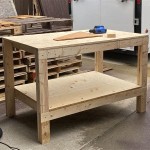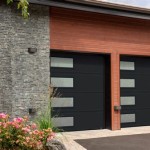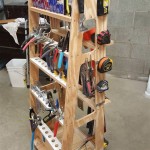How to Build Garage Storage Racks
Garage storage racks offer a versatile solution for maximizing space and organizing belongings. Building custom racks allows for tailoring dimensions and weight capacities to specific needs and readily available materials. This guide outlines the process of constructing robust and practical garage storage racks.
Planning and Preparation: Accurate planning is crucial for a successful project. Begin by assessing the available garage space and determining the desired dimensions of the racks. Consider the types of items to be stored, estimating their weight and volume. This informs the required rack dimensions, material strength, and overall design.
Material Selection: Common materials for garage storage racks include wood and metal. Wood is generally less expensive and easier to work with, ideal for lighter items. Pressure-treated lumber is recommended for durability and moisture resistance. Metal, such as steel, provides superior strength and load-bearing capacity for heavier items, but requires more specialized tools and welding skills.
Design Considerations: Several design factors influence the rack's functionality and stability. Vertical supports should be adequately spaced to prevent sagging under load. Horizontal supports determine the shelf depth and should be securely fastened to the vertical supports. Consider incorporating bracing elements for added rigidity, particularly for taller racks or heavier loads. The depth of the shelves should accommodate stored items while maintaining accessibility.
Tool and Equipment Gathering: The necessary tools depend on the chosen material. For wood construction, essential tools include a measuring tape, saw (circular saw or handsaw), drill, screwdriver, level, and safety glasses. Metal construction necessitates a metal cutting saw, welder, grinder, clamps, and appropriate safety gear. Ensure all tools are in good working order and safety precautions are observed throughout the project.
Construction Process (Wood): Begin by cutting the lumber to the determined dimensions for vertical supports, horizontal supports, and shelving. Use a level to ensure accurate vertical and horizontal alignment during assembly. Securely fasten the horizontal supports to the vertical supports using screws or bolts. Add bracing elements for increased stability, especially for taller units. Once the frame is assembled, attach the shelving material, ensuring it is evenly spaced and securely fastened. Sand any rough edges and apply a sealant or paint for enhanced durability and appearance.
Construction Process (Metal): Cut the metal stock to size according to the design specifications. Use a welder to join the vertical and horizontal supports, ensuring strong and clean welds. Incorporate bracing elements for added rigidity. Grind down any sharp edges or excess weld material. For shelving, metal sheeting or plywood can be used, secured with bolts or welding. Apply a rust-resistant primer and paint for protection and longevity.
Installation and Securing: Position the assembled rack in the designated location within the garage. For wall-mounted racks, ensure secure anchoring to wall studs using appropriate fasteners. Freestanding racks should be placed on a level surface and, if necessary, anchored to the floor for added stability, especially in earthquake-prone areas. Consider adding rubber feet to the base of the racks to protect the garage floor and prevent slippage.
Weight Capacity and Safety: Accurately assess the weight capacity of the constructed racks based on the materials used and design. Avoid overloading the racks beyond their capacity, which can lead to structural failure and potential injury. Label the racks with their maximum weight capacity as a reminder. Regularly inspect the racks for any signs of damage or wear and tear and address any issues promptly.
Customization and Enhancements: Garage storage racks offer various customization options. Consider adding drawers, cabinets, or bins for organizing smaller items. Hooks can be attached to the sides or underside of shelves for hanging tools or sporting equipment. Labeling shelves and containers enhances organization and accessibility. Adjust shelving heights as needed to accommodate changing storage needs.
Maintenance: Regular maintenance ensures the longevity and functionality of garage storage racks. Periodically clean the racks to remove dust and debris. Inspect for any signs of damage, such as loose screws, cracked wood, or rust on metal components. Reapply sealant or paint as needed to protect the materials from moisture and wear. Address any repairs promptly to prevent further damage and maintain the structural integrity of the racks.
Building garage storage racks provides a customizable solution tailored to specific needs. By adhering to proper planning, material selection, construction techniques, and safety considerations, durable and functional storage solutions can be achieved, maximizing garage space and organization.

How To Build Shelving In A Garage Three Ways Ana White

Best Diy Garage Shelves Attached To Walls Ana White

How To Build Garage Shelving Easy And Fast

And Easy Diy Garage Shelves Building Plans Pneumatic Addict

Super Efficient 2x4 Garage Shelves Diy Storage

Easy Diy Garage Shelves With Free Plans Fixthisbuildthat

Easy Diy Garage Shelves With Free Plans Fixthisbuildthat

Garage Shelves Plans Wilker Do S

Diy How To Build Suspended Garage Shelves Building Strong

Diy Garage Shelves 5 Ways To Build Yours Bob Vila
Related Posts








